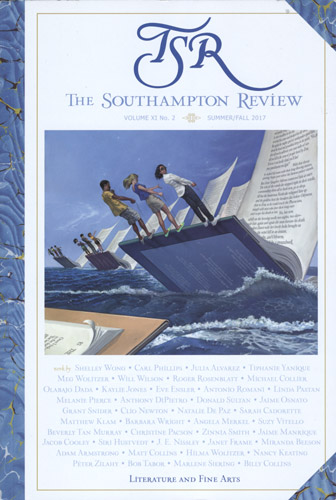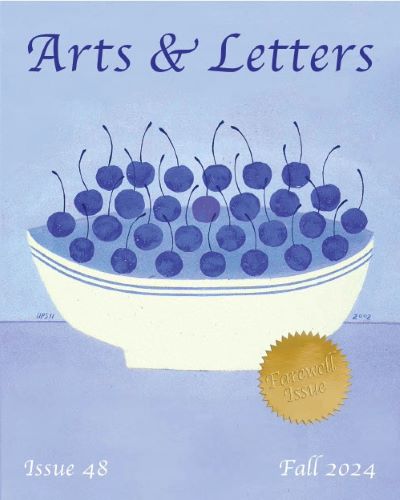The Southampton Review – Summer/Fall 2017
When is a treat too rich? The Summer/Fall 2017 issue of The Southampton Review is an overwhelming collection of multi-genre pieces, and it is definitely no exaggeration that it is hard to find a starting point. This tenth anniversary edition is a fine tribute to the vision and efforts of its editors.
When is a treat too rich? The Summer/Fall 2017 issue of The Southampton Review is an overwhelming collection of multi-genre pieces, and it is definitely no exaggeration that it is hard to find a starting point. This tenth anniversary edition is a fine tribute to the vision and efforts of its editors.
The art certainly stands out during the preliminary overview. Will Wilson’s “A Photographic Exchange” demonstrates what a 19th century developing process can do for a tintype. The result provides us with a collection of faces that recall our history through contemporary portrayals; the documentary quality impresses with its depth of character.
I don’t want to slight the artists of text, but the visual works of Jacob Cooley, Bob Tabor, Clio Newton, and Donald Sultan are so impressive that cutting up a journal to hang the pieces as they are does not seem like literary sacrilege. Newton’s charcoal drawings, which must be incredibly impressive in their full five feet by eight feet, are no less striking on these pages; Sultan’s use of tar and tile provide a new perspective on color; and Cooley’s landscape paintings are as striking as the land they depict.
There are twelve distinct and exemplary pieces of fiction, each of which provides insight into human nature and the responses we have to events that may not be as extraordinary as we would like to think. We move from culture to culture, social level to social level, but we recognize the responses of the principal characters. All twelve pieces readily engage and impress, with some standing out more than others. There’s Olabajo Dada’s “The Bar Beach Show,” and Christine Pacson’s “Asa Guerrero” as prime examples of human involvement and feeling. In Dada’s work, setting makes the moments of human nature shine:
At the other end of the city, under a billboard that advertised the Bar Beach Show on one side and featured the picture a beaming General Buhari on the other, brandishing a whip and begging LET’S MAKE NIGERIA A BETTER PLACE, Akanji fanned himself with the stack of papers where he drew his casket designs, cursing under his breath at the long line in front of him.
The creative nonfiction is no less engaging; the nine pieces draw us into a variety of experiences and perspectives. From Melanie Pierce’s excerpted “Selah”:
And for 15 years, the joy of my salvation had felt lackluster. Even when I wasn’t pregnant. I felt weighted, as though concrete filled my womb. But then, all at once I didn’t need to repent of my discontent anymore. I didn’t have to muster up some speech about rejoicing in the Lord at the Ladies’ Bible Study. The canvas started gathering dust underneath the bed; the silty gray muted the brightness of the paint. My bones, my gut, the very roots of my hair—they were packed tight with happiness.
An excerpt from a speech by Chancellor Angela Merkel in 2009 gives us insight into why she is re-elected by the German people: “I am convinced that, [ . . . ] today we have the strength to overcome the walls of the 21st century, walls in our minds, walls of short sighted self-interest, walls between the present and the future.”
The poetry is another assortment of pieces from the elegant to the purely entertaining. My favorites include Michael Collier’s “Koi”:
But it was not until we cast handfuls
in careless, strafing arcs, that they thrashed and roiled.
tails and fins breaching water, white and turbid.a ferocity that ceased as quickly as it began.
and though we cast more,
they turned away: lumbering, disinterested, unschooled,
moving fluidly, impossibly avoiding contact. And so
they came to rest not without motion
but anchored like a fleet.
There is also the ‘home’ feeling of Billy Collins’s work, including “Empty House”:
I wonder—
did you happen
to play something new
on the pianobefore you left
or was it just the breeze
from the door
you left open
that turned the page?
And there’s more to find in this issue of The Southampton Review . . . Yes, there are cartoons! Grant Snider and Matt Collins ‘give us a break’ with diversions of language and image; both equally entertaining.
Memorial pieces for Byron Dobell, Thomas Lux, and Derek Walcott provide a fitting tribute to fellow artists, and The Frank McCourt Memoir Prize winners finish a seriously full package of literary categories in what is a highly commendable collection of literature.
[www.thesouthamptonreview.com]





